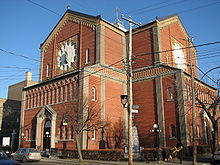|
La Petite-Patrie
La Petite-Patrie (French pronunciation: [la pətit patʁi]) is a neighbourhood of Montreal, Quebec, Canada. It is located in the borough of Rosemont–La Petite-Patrie. The area is bounded on the west by Hutchison Street, to the north by Jean Talon Street, to the south by the Canadian Pacific Railway tracks, and to the east by d'Iberville Street. La Petite-Patrie is named after the novel La Petite Patrie by Claude Jasmin, which was published in 1972 and was adapted into television series (La Petite Patrie) shortly afterward. Originally a working-class neighbourhood, La Petite-Patrie began to gentrify in the early 21st century.[citation needed] HistoryUntil the late 19th century, La Petite-Patrie was mainly agricultural, with the exception of limestone quarries, now the location of Père Marquette Park. The construction of a tramway in 1892 linking downtown to Sault-au-Récollet led to the urbanization of the area, which continued until about 1930. It was still a predominantly-residential neighborhood since the only employment was concentrated along the railway, in the workshops of Montreal, or in the Montreal Street Railway. DemographicsA report by the Centre de santé et de services sociaux (CSSS) du Cœur-de-l'île,[1] the neighborhood's population consists of:
The area includes several ethnic communities, including an Italian community, a Vietnamese community and a Latin American community. TransportRoadsThe main roads in La Petite-Patrie include (street directions according to street grid, not geographical): 
Public transit
Bicycle paths
Public services
Education The Commission scolaire de Montréal (CSDM) operates Francophone public schools. The English Montreal School Board (EMSB) operates Anglophone public schools. The Montreal Public Libraries Network operates the La Petite-Patrie library[2] and the Bibliothèque Marc-Favreau, which opened in December 2013.[3] Sports and recreation
Economy
Places of worship
References
|
||||||||||||||||||||||

